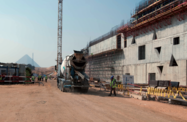Improved performance in Egypt’s key sectors, tighter fiscal management and increased capital inflows drove an economic rebound last year, with growth expected to accelerate further in 2018.

Egypt’s economy continued on an upward trajectory in FY 2016/17, posting growth of 4.2%, compared to projections of 3.5%, according to the IMF. Growth in the second half of the year, in particular, accelerated, expanding at an average rate of 4.6% at market prices – the fastest pace since FY 2009/10.
Tourism rebounds, expanding by 3.9%
A key contributor to the recovery of the economy was tourism, which is on the rebound following concerns over political stability and security. According to preliminary data from the Central Bank of Egypt (CBE), the sector recovered from a contraction of 25.5% in FY 2015/16 to post growth of 3.9% in FY 2016/17.
Growth has been supported not only by a higher number of arrivals from traditional source markets, such as Western Europe, but also visitors from new markets, including China and the Gulf, according to press reports.
The best performing sector in FY 2016/17, however, was communications, which recorded growth of 12.5%, followed by construction and transport, which expanded by 9.5% and 5.3%, respectively. Agriculture and manufacturing, traditional mainstays of Egypt’s economy, posted gains of 3.2% and 2.1%, while extraction industries declined by 1.8%.
An increase in investment flows also helped build momentum; net foreign direct investment reached 3.4% of GDP during the period, according to the Ministry of Finance (MoF).
Increases in energy exports, up 15.4% over FY 2016/17, coupled with a 16.2% rise in non-oil exports, also contributed to the economy’s performance and were a reflection of the positive impacts associated with the 2016 liberalisation of Egypt’s exchange rate, according to the CBE.
Going forward, Amr El Garhy, the minister of finance, projected growth of 5-5.25% for FY 2017/18, up from earlier estimates of between 4.6% and 4.8%.
Deficit falls to 2% of GDP
The strengthening economy has had a positive impact on state finances; the fiscal deficit dropped to 2% of GDP by the end of September, down from 2.2% at the same time last year, according to the MoF.
The current account deficit also saw a reduction – of 21.5% in FY 2016/17 and 65.7% y-o-y in July-September – while capital inflows strengthened, with $29bn and $6.2bn coming from external sources over the respective periods.
This led to an improved balance of payments; the country recorded a $13.7bn surplus in FY 2016/17, up from a $2.8bn deficit in the preceding 12 months, CBE data showed.
Inflation down, unemployment easing
Another positive throughout 2017 has been a reduction in the price of goods, as inflation dropped to 26.7% in November, the lowest level since December 2016.
While some components like food and beverages remained above the average, at 32.4%, others such as transport and utilities were well below 20%, helping to bring down the index, according to the Central Agency for Public Mobilisation and Statistics (CAPMAS).
Despite waning inflation, the CBE maintained its hold on rates, keeping key benchmarks unchanged during its December review. The bank left the overnight deposit rate at 18.75% and the overnight lending rate at 19.75%, remaining confident of meeting a projected inflation rate of 13% by August 2018.
Unemployment also continued to ease amid improvements in the economy, with the jobless rate falling from 12.5% at the beginning of the year to 11.9% by the end of September, its lowest since 2011.
Release of loans improves outlook
Egypt’s positive economic performance looks set to continue in 2018, after the IMF agreed to release a $2bn tranche of funds as part of its $12bn loan programme.
The decision means Egypt has now received $6bn from the three-year programme, signed in November 2016, which has seen the government introduce a series of tax reforms and spending cuts to help stimulate growth in the economy.
Further international support for the reform process came from the World Bank, which in December agreed to provide $1.15bn in loans to strengthen public finances.
The granting of the loan has been tied to efforts to scale back subsidies and lift revenue, along with strategies to drive job creation, boost energy security and enhance business competitiveness, especially in the small and medium-sized business segment.
The credit brings the bank’s total loans to $3.15bn, with the funding likely to support stronger growth and a continuation of the reform process in 2018.


